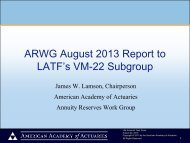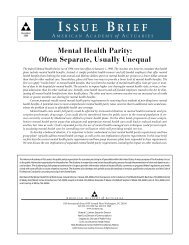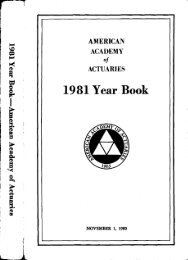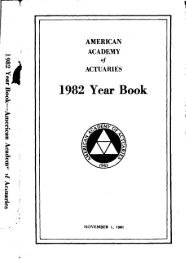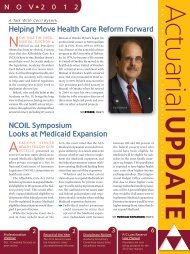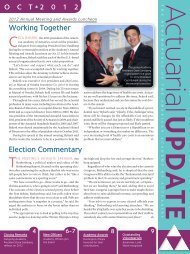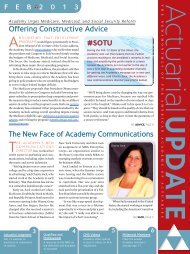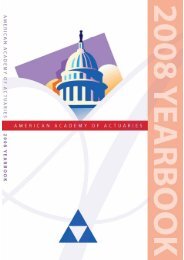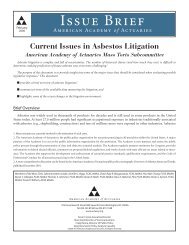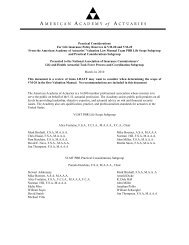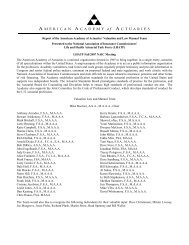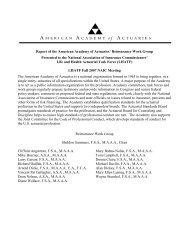Comments - American Academy of Actuaries
Comments - American Academy of Actuaries
Comments - American Academy of Actuaries
You also want an ePaper? Increase the reach of your titles
YUMPU automatically turns print PDFs into web optimized ePapers that Google loves.
<strong>American</strong> <strong>Academy</strong> <strong>of</strong> <strong>Actuaries</strong>’ 1 Solvency Committee comments on ComFrame<br />
Paragraph ComFrame text Proposed IAA <strong>Comments</strong> <strong>Academy</strong> comments<br />
Reference<br />
General <strong>Comments</strong> General <strong>Comments</strong> Different sections require demonstrating or analyzing The committee 1 concurs<br />
some aspect <strong>of</strong> the company’s risk management. The<br />
document as written could imply a requirement for<br />
voluminous reporting that is duplicative <strong>of</strong> the ORSA.<br />
For example, some items listed that would likely be<br />
covered in an ORSA include – p. 46 Guideline M2E3-2-<br />
8-2, p. 48 Guideline M2E3-3-2-1, Guideline M2E3-3-6-<br />
1 and 2 p. 56 Guide M2E4-4-1-2 (U/Wing policy needs<br />
a feedback loop to ensure emerging risks are<br />
considered) p. 59 Par. M2E4-7-1 Reinsurance strategy<br />
should be in ORSA?<br />
General <strong>Comments</strong> General <strong>Comments</strong> One other unaddressed item that emerges is “What is The committee concurs<br />
appropriate and what are the consequences <strong>of</strong> failure?<br />
Some examples include p. 52 Parameter & Guideline<br />
M2E4-1-1 What is undue reliance? p. 53 Par. M2E4-1-3<br />
p. 56 Guideline M2E4-4-1-3 How to tell if reinsurance<br />
program exposes the balance sheet beyond its risk<br />
tolerance levels (actually seems redundant, seems to be<br />
written more like a notice to the regulator <strong>of</strong> what to<br />
consider). In any case, this is an area where the use <strong>of</strong><br />
actuarial standards and the IAIS requirements might be<br />
helpful. Also, as indicated in the notes, what will be the<br />
regulator tolerance for “failure” or weak compliance? In<br />
national jurisdictions, there are specific legal powers<br />
linked to instances <strong>of</strong> failure or weak compliance. But,<br />
since the IAIS standards to not have legal authority, the<br />
actuarial standards might be written to be more <strong>of</strong> a<br />
dialogue and focused on how to improve the company<br />
process no matter where the level <strong>of</strong> compliance exists.<br />
General <strong>Comments</strong> General <strong>Comments</strong> Lastly, the guidance seems silent on the specifics <strong>of</strong> a The committee concurs<br />
diversification credit – How will it be handled? It is<br />
referenced on p. 50 Guideline M2E3-4-1-2, but not<br />
described elsewhere and if (or how) it is allowed.<br />
General <strong>Comments</strong> General <strong>Comments</strong> No relevant IAA reference The IAIS document still includes<br />
1 “Committee” refers to the <strong>American</strong> <strong>Academy</strong> <strong>of</strong> <strong>Actuaries</strong> Solvency Committee<br />
1850 M Street NW Suite 300 Washington, DC 20036 Telephone 202 223 8196 Facsimile 202 872 1948 www.actuary.org 1



